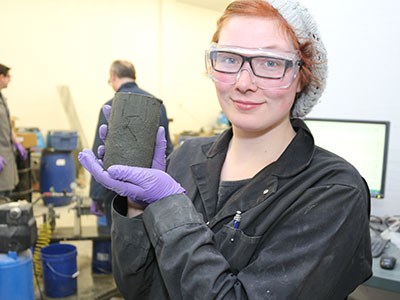To the untrained eye, a visit to Kovit Engineering’s lab in Sudbury looks like a number of adults playing with combinations of sand, silt and water.
On the surface, the lab might have a lot in common with a children's playground, and the wide-eyed experimentation that comes with getting one’s hands
dirty.
But to Frank Palkovits, one of Kovit Engineering’s four co-owners, what goes on in the 3,500-square-foot laboratory is serious business.
Kovit Engineering consults with mines around the world to help them manage their on-surface tailings and backfill.
The company specializes in what it calls “paste technology,” first developed by Inco in Sudbury, and later perfected by Golder Paste Technology in the mid-1990s.
Palkovits worked for both companies, and in June 2011 teamed up with Paul Rantala, Steve Reichle and Mark Wallgren to found Kovit Engineering.
From its humble beginnings, the company expanded to a 13,000-square-foot facility in Sudbury last December.
Kovit employs 30 people with the average salary in the $80,000 a year range, and thanks to new contracts, could double its workforce to 60, said Palkovits.
The paste technology the firm develops in-house represents a natural extension of backfill and tailings management.
In the earliest days of underground mining, miners moved on after a stope had been exhausted of its minerals.
Sometimes these mine sections would collapse, killing those underground.
Mining companies later filled exhausted sections with combinations of sand and water, and later added cement to improve structural integrity.
But the consistency of sand wasn’t always ideal for backfill, especially when large quantities of water were involved.
Inco (now Vale) discovered it could create a paste, using the tailings it removed from its mines as the main ingredient, with a consistency similar to toothpaste.
Palkovits calls this a “Goldilocks” solution that sits somewhere in between a coarser gravel and a light sand.
The paste can be transported in underground pipelines without causing too much wear and tear, and has just the right consistency in many situations to create a solid foundation for a backfill.
The paste also proved to be a sustainable way to manage a mine’s tailings.
“With paste technology we can get a much smaller (environmental) footprint,” Palkovits said.
A lot of a mine’s unused material can go towards creating a paste that works great for backfill, and can also help build more sustainable tailings ponds.
For surface tailings management, the company instructs mines to deposit the tailings paste in different areas where it can dry out.
Once the initial layer is dry, the mine can add an additional layer of the paste on top. The saturated top layer prevents oxygen from getting into the tailings, which in turn reduces the chances of acidification.
“You can layer quite reactive tailings in a very safe environment that is geotechnically and geochemically stable,” Palkovits said.
Mining companies around the world mail their tailings samples to Kovit Engineering so the company’s researchers can concoct the perfect paste recipes with their ingredients.
“We test them for how they thicken, how they filter, how they flow as a paste, how they get strength with cement or other types of binders,” Palkovits said.
The Kovit lab – which Palkovits said is the largest of its kind in the world – is full of instruments, both high- and low-tech, to measure all the different properties of the pastes.
For more information, visit koviteng.com.




